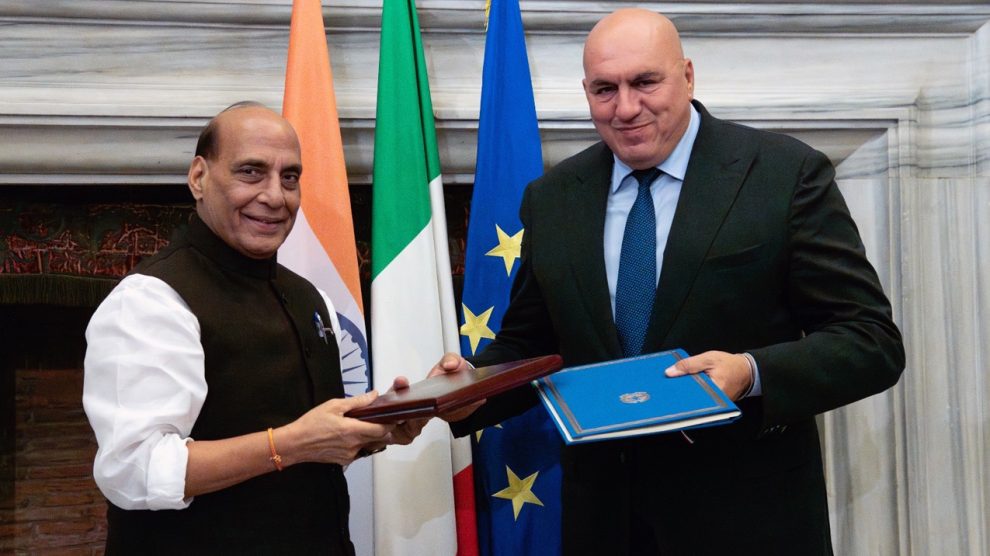Rome and New Delhi renew defence partnership. On Monday, Italian Defence Minister Guido Crosetto welcomed his Indian counterpart Rajnath Singh in Rome – the first of a series of Indian ministers slated to visit the Italian capital between now and year’s end. The two renewed their countries’ agreement for cooperation in the defence sector, which had expired in 2019 due to frictions around the Enrica Lexie case.
- A note from the Italian Defence Ministry describes the renewal as an essential step “to establish a relationship between governments in areas of mutual interest, improve the exchange of personnel, technologies for practice, as well as training and exercises.”
- “Italy and India share a sense of respect for other countries in the international community,” remarked Minister Crosetto, noting that the signing “has a high strategic value to relaunch our fruitful bilateral relations, also considering the changed geopolitical scenario.”
The great thaw. The defence agreement renewal is a by-product of the strengthening of bilateral relations against the backdrop of a shifting international scenario marked by increased Chinese assertiveness and Russia’s aggression against Ukraine. Back in March, when Prime Minister Giorgia Meloni visited New Delhi, she and PM Narendra Modi upgraded the Italy-India relation to a strategic partnership.
- The day before, Sparkle (the global operator of Italy’s Tim Group) had started laying the BlueMed undersea cable, the first part of a new Italy-India data route – a connection between Europe, Africa, the Middle East and Asia by connecting Italy, France, Greece and Israel (Blue System) and Jordan, Saudi Arabia, Djibouti, Oman and India (Raman System).
- Also, a few weeks earlier, Defence Undersecretary Matteo Perego di Cremnago had attended the Aero India Show in Bangalore, where he met his local counterparts to finalise the renewal of the agreement.
The other dossiers. Ministers Crosetto and Singh also discussed instability in the Middle East (in light of the recent terrorist attacks in Israel) and spoke of the “strong focus” on the UNIFIL mission in Lebanon, where the two armed forces are jointly engaged. To Rome, the Middle Eastern region is part of the enlarged Mediterranean (i.e. the geostrategic projection area for Italian foreign policy interests), while New Delhi is also engaged in the region via oil purchases and planned collaborative projects with major regional players, starting with Israel.
- Italo-Indian cooperation is also strategic concerning the African continent, which will be one of the priorities during the G-7 Italian presidency of 2024 (where India will most likely be invited as a guest) and was highlighted during the G-20 Summit in New Delhi (where the African Union was invited to become a permanent member).
Linking the Med and the Indo-Pacific. “At a time when global stability requires a joint commitment, it is crucial to invest in improving relations with non-NATO countries in order to address global problems and emerging challenges. The geographical distance between the Mediterranean and the Indo-Pacific is less than one might imagine, and the interconnection between the two regions is strong,” explained Minister Crosetto.
- Rome has been working on this interconnection for some time as a gateway to the Indo-Pacific region (where the Indian Ocean and the enlarged Mediterranean link, in a continuity of geostrategic issues, across the Arabian Sea, the Strait of Bab-el-Mandeb, the Suez Channel).
- Projects such as the India-Middle East-Europe Economic Corridor (IMEC), presented during the G-20 Summit in New Delhi, are based on these conceptualisations – which become a set of infrastructural, and thus geopolitical, links connecting India with the West, a “strategic imperative” for Italy.
Italy in the Indo-Pacific. The Indian Defence Minister has invited the Italian Armed Forces to participate in a joint exercise with logistic support in India. Italy is already actively engaged in this key strategic quadrant with the European naval operations EUNAVFOR Somalia, Operation Atalanta (to counter piracy in the Indian Ocean) and European Maritime Awareness – Strait of Hormuz (EMASOH). These are all missions that aim to develop structured cooperation with countries in the area with shared interests and values.
- The Italian patrol vessel Morosini has just completed a naval campaign in this strategic sector, where it carried out training activities with the main countries in the area.
- In August, the Italian Air Force was engaged in joint training activities with Japanese colleagues.
- Finally, Italy’s flagship aircraft carrier Cavour – whose squadron includes at least four escort and support units – is set to reach Indo-Pacific waters by late 2023 and early 2024.




